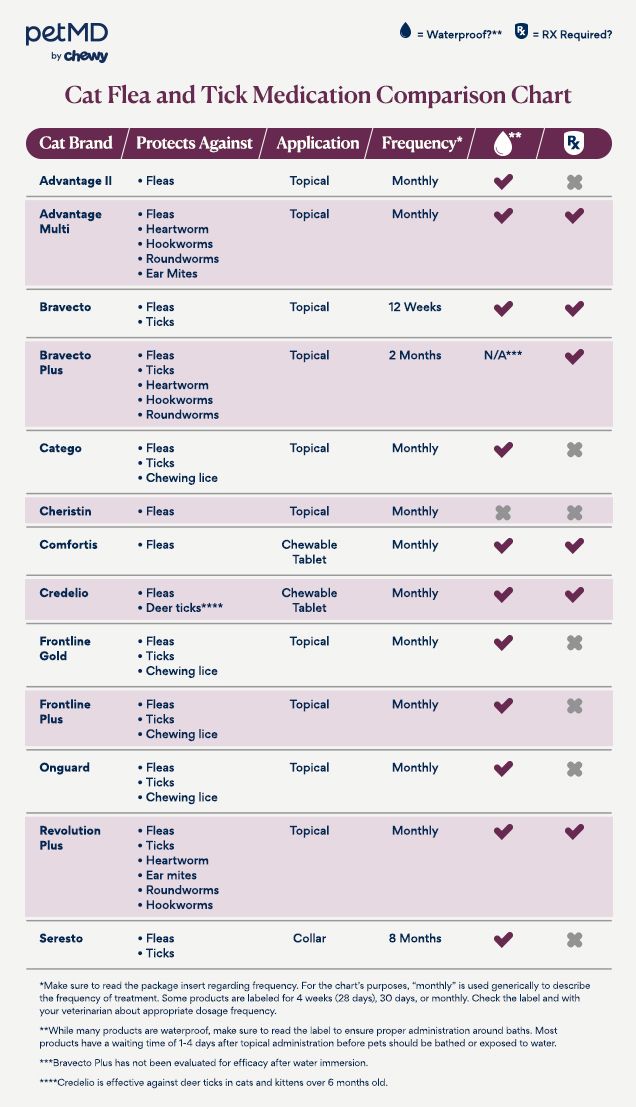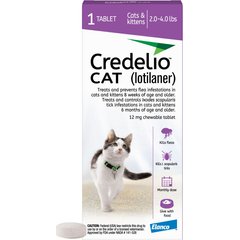Flea and Tick Prevention and Treatment for Cats
Remains/iStock / Getty Images Plus via Getty Images
Tick and flea infestations are two of the more common issues facing pets and their parents. Because of this, tick and flea treatment for cats is an essential part of your pet’s care routine.
Using a monthly flea and tick medicine for cats can ensure your furry companion stays healthy and pest-free.
Key Takeaways
- Fleas and ticks can cause several diseases in cats.
- Always keep all pets on year-round prevention, regardless of the season, the weather, and your location in the United States.
- Speak with your veterinarian and discuss the best option for your specific pet.
Why Is Flea and Tick Treatment and Prevention Important for Cats?
Fleas and ticks are known as ectoparasites—parasites that live on the outside of the host animal. Both fleas and ticks survive by taking a blood meal, which means they must bite their host to draw blood for food.
While the bite itself is small, flea saliva can cause the following issues in cats:
Tick bites can also cause:
In addition to allergic reactions, fleas and ticks can also transmit a variety of diseases to cats, including:
-
Rocky Mountain Spotted Fever
Cats aren’t as susceptible to tick-borne diseases as dogs, but there is still a risk of illness.
In some cases, ticks can also transmit diseases to cats that can then infect humans (zoonotic diseases).
The best way to prevent flea and tick allergies, or to reduce the risk of spreading diseases, is to prevent infestation in the first place.
Fortunately, there are a variety of products to help keep your feline friend free of parasites.
Let’s take a look at how to pick the best tick and flea treatment for cats.
Choosing a Flea and Tick Treatment and Prevention Medication
There are many combination preventatives for cats—which can make it confusing to pick the best product for your furry friend.
Speak with your veterinarian and discuss the best option for your specific pet. When discussing options, it's important to keep the following key factors in mind.
Species
Dog products can’t be used on cats and will lead to severe (often fatal), reactions. Insecticides in these drugs are called permethrins.
These insecticides are toxic to cats, potentially causing tremors, seizures, and death.
Thoroughly check the label and get approval from your vet before applying any tick and flea treatments to your cat.
Application Method
The most common tick and flea treatments for cats are administered either orally, in the form of a chewable tablet, or as a topical liquid spread between the shoulder blades or down the back.
Topical Flea and Tick Products for Cats
Topical products may not be the best fit for some households with small children or other animals that may touch or lick the product before it dries.
Spot-on topical treatments can often have a medicinal smell or cause transient itching/irritation or even hair loss.
Depending on the bathing frequency and your cat’s skin and hair coat, topical treatments are also potentially less effective.
Oral Flea and Tick Products for Cats
Oral treatments require your cat to eat the entire tablet. This means you’ll have to watch your cat more carefully to make sure they ate the whole dose.
Being watchful is especially important if your cat doesn’t like the taste of the pill.
If your cat vomits after eating an oral flea and tick preventative, call the manufacturer or veterinarian for instructions on re-dosing, as well as to report a potential reaction to the product.
Feeding oral preventatives with a meal may help decrease upset stomach and help make the medicine easier to absorb.
Geography
Different geographic locations have different local parasite populations, including fleas and ticks, as well as other parasites such as heartworm and intestinal worms.
The Companion Animal Parasite Council is a terrific resource to identify the parasites in your specific area that put your pet at the most risk.
Access to Outdoors
Cats allowed outdoors are at much higher risk of encountering fleas and ticks, especially in wooded, thick, or untreated yards.
Using a flea and tick preventative is especially important in these cats to reduce the risk of infestation.
However, even if your cat is kept indoors, there is still a risk—especially for flea bites.
Fleas can easily enter your home through window screens, on other pets who go outside, or even on a pet parent’s pants and shoes.
For those animals living in townhouses or apartment buildings, fleas can be shared between living spaces.
That’s why veterinarians recommend that all animals—regardless of access to the outdoors—have year-round flea and tick prevention.
Lifestyle Characteristics
A very small percentage of cats carry a genetic risk factor for a mutated gene that causes drug sensitivity.
These cats cannot safely process certain drugs, including some ingredients in preventatives, which can result in a life-threatening reaction. Many veterinarians recommend testing cats for the MDR-1 gene, especially affected breeds.
The Washington State University has additional information on the mutation—and which drugs to avoid.
While there are no cat breeds that are especially vulnerable to flea or tick infestation, some cats may be at higher risk due to their personality and breed characteristics.
This includes their spay or neuter status.
Intact cats may spend most of their day roaming outside, while spayed or neutered cats are content to stay at home, only venturing outside occasionally.
Similarly, some exotic breeds (such as Manx or Bengal) may be more likely to adventure and hunt outdoors.
High-risk cats may benefit from multiple products to ensure full parasite coverage. Speak to your veterinarian to see if this option is right for your individual cat.
Life Stage
If you have a new kitten or your cat is on the smaller side, talk with your veterinarian about which flea and tick preventatives are safe before choosing a product.
Not all products can be used in all life stages or weights. Most preventative’s minimum age is 6–8 weeks of age, but always check the package insert for confirmation.
Many tick and flea treatments for cats also have a minimum weight required for safe use.
Medical Conditions
Most parasite preventatives are extremely safe, but there are some exceptions.
Some classes of preventatives, called isoxazolines, should be used with extreme caution in cats with a history of seizures or neurologic disease. These medications have been shown to reduce the seizure threshold.
No preventative should be used without thorough discussion with your veterinarian if:
-
Your pet has previously had an allergic reaction to the drug
-
Your pet is sick and/or underweight
-
Your pet is pregnant, nursing, or will be used for breeding in the future
Over-The-Counter vs Prescription Flea and Tick Medicine
Over-the counter (OTC) tick and flea treatments for cats do not require a relationship with or prescription from a veterinarian.
They are typically available for purchase online and in many retail pet stores.
Prescription flea and tick preventatives require a prescription from your veterinarian and typically cost a little more.
However, even if you’re using an OTC product that doesn’t require a prescription, always consult with your veterinarian to make sure it is a safe option for your cat.
Most veterinarians recommend prescription products, as they are typically more effective and safer for your cat.
Comparing Common Flea and Tick Preventatives and Treatments
This chart outlines and compares common tick and flea treatments for cats to help you determine which option is best for your furry friend.

When Should You Use Flea and Tick Prevention for Cats?
Always keep all pets on year-round prevention, regardless of the season, the weather, and your location in the United States.
Flea and Tick Prevention and Treatment FAQs
What is the most effective flea treatment for cats?
Oral flea treatments are known to be much more effective at kills fleas than topicals.
Oral preventions act quicker, as they are absorbed into the bloodstream much sooner than something applied to the skin.
How do vets get rid of fleas on cats?
Vets will get rid of the fleas in cats the same way pet parents can do so at home.
This often starts with a bath in Dawn dish soap to remove any fleas or flea dirt on the cat. This is followed by giving an oral flea treatment/prevention such as Comfortis.
If a bath is not an option for your cat, Capstar is an oral pill that kills live fleas over the course of 24 hours. Capstar can be given safely with most traditional flea treatments.
How often do indoor cats need flea treatment?
Cats kept inside can certainly get fleas—though maybe not as often as a community cat or a cat that’s allowed to roam outside. However, it’s more common than you would think.
Often, people can be the vector that brings fleas into the home on shoes or clothing.
Fleas also enter the home the same way other insects do—through cracks or windows. It’s important that all cats be on year-round flea control.
References
-
American Veterinary Medical Association. Safe use of flea and tick preventative products.
-
Clinician’s Brief. Isoxazolines.
-
U.S. Food & Drug Administration. Safe Use of Flea and Tick Products in Pets


